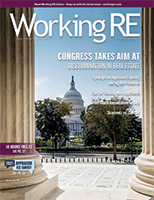 |
“One of the best courses that I have had in 17 years!” -Amy H
>> OREP E&O |
>> Editor’s Note: Share your experience with trainees in Working RE’s Survey for Trainee Supervisors and help the entire industry. Take the four-minute survey now.
Stairway to Confusion
by C. Brett Bowen
There has been considerable discussion over the years about gross living area (GLA) measurement standards. The ANSI Z765 standard gets the lion’s share of the attention, and is the most widely referenced standard in the industry by far. It can also be the most difficult to interpret, particularly when it comes to stairs. Here’s why.
It is primarily important to recognize two very important facts:
1) a standard is nothing more than the definition of a unit of comparison and
2) it is the appraiser’s responsibility to be consistent with that definition.
First, what do I mean when I say that a standard is nothing more than the definition of the unit of comparison? The unit of comparison for something is critical to the understanding of that thing.
If I go to London and buy a souvenir, and the cashier says the price is 15, I need to know what unit of comparison we are talking about. Is that 15 Pounds Sterling or 15 Euros? Did the cashier happen to notice my accent and give me the price in US Dollars? The unit of comparison in this example is the currency. Knowing the currency is critical to my evaluation of that price. The same applies to GLA. The standard defines what unit of comparison we are using. In other words, when I use the term “gross living area,” what do I actually mean? The standard that I’m using is what gives meaning to that term.
Second, as an appraiser, consistency with the definition is actually more important than which definition is chosen. It is not merely consistency with oneself, or even with other appraisers, which is key: it is consistency with your data which is most important. If you believe that your standard of GLA is best, but those who are reporting comparable sales data are utilizing a completely different standard, it is your responsibility to either change your standard, or convert the data to match your standard.
Maybe this example will provide some clarity on this issue: Properties A, B, and C are the same floor plan as the subject property and have sold recently. The builder’s architect has reported the GLA of that floor plan to be 2,800 square feet using their standard for calculation of GLA. An appraiser measures the subject property using a different standard and arrives at a GLA calculation of 3,000 square feet. Before the appraiser utilizes properties A, B, and C as comparables, it is imperative that the appraiser recognizes that their standard is inconsistent with the standard which is reported in the market. Addressing the inconsistency is far more important than whether or not the appraiser’s measurements are “right” or “better.”
This lack of consistency is being a big problem and a big business. There are many appraisers who market their measurement services to agents with the specific understanding that their interpretation of ANSI will likely result in a larger GLA than what is reported. Why is this a problem? Ethics. If I am knowingly using a method of arriving at GLA which is substantially different from the methods employed by most architects, builders, and tax assessors, then the assignment results are knowingly misleading. If I know that on average my method of measurement produces a GLA 5% higher than what is typically reported of my comparables, then choosing that method without dealing with the inconsistency is unethical and a violation of the Uniform Standards of Professional Appraisal Practice (USPAP).
Consistency
So how do you deal with the inconsistency? There are two solutions. The first is simply to adopt the standard (or the interpretation of the standard) which is prevalent in my market. The second solution is to revise the GLA of my comparable data by extrapolating what the GLA of the comparable data would be under the methodology utilized by the appraiser. While this solution is theoretically ethical and USPAP compliant, it comes with some obvious flaws in practice. How do you know what the GLA of that comparable would be if it were calculated using your preferred method?
This brings us back to the confusion regarding ANSI and stairs. While the recent update to the standard (ANSI Z765-2021) provided some additional clarification in some areas, there remains some significant room for interpretation when it comes to the stairs. This is particularly true when the subject lacks a basement.
Two-story homes are very common in my market but basements are not. A common floor plan includes a switchback staircase to the second floor with a closet underneath which extends several feet under the staircase with a sloping ceiling in the closet. The question is where do you count the stairs? On the first floor, on the second floor, on both floors?
(story continues below)
(story continues)
Increasingly, I am finding that appraisers are interpreting the standard to include the entire staircase on both levels. I’ll be the first to admit that this interpretation has some basis, although it does create some inconsistencies with other parts of the standard, and seems to be at odds with the methods of architects, builders, and assessors (at least in my market). This interpretation relies most heavily upon the illustrations.
The published standard includes several illustrations which are intended to clarify several elements of the standard, however, the illustrations alone can be confusing, especially if you don’t read the full standard itself. The illustrations depict a home with three levels: first floor, second floor, and a basement. The floorplan depicts a staircase descending from the second floor to the first floor, and then down to the basement. If you just look at the illustration, it indicates that the staircase is included in the GLA on both the first and second floors. However, it is important to read the standard to understand why. The standard states that “the area of both stair treads and landings proceeding to the floor below is included in the finished area of the floor from which the stairs descend…” (ANSI Z765-2021, page 6, emphasis added). The Annex to the Standard, which provides additional commentary, states that “stairs that descend to an unfinished basement are included in the finished square footage of the first level…” The parts of the standard which indicate that ceiling height under the stairs doesn’t matter, all appear to be in the context of stairs on the basement level. Therefore, if there is no basement, then there are no stairs which descend into the basement which should be counted on the first floor. The GLA above grade (ie, the area under the stairs which does not descend into a basement) appears to be treated differently.
My primary evidence is that of the strict adherence to the minimum height requirements in the same example. In their example, the area which slopes below a ceiling height of 5′ is not included in the GLA calculation. Therefore it would be contradictory to exclude such a space in one part of the house and then include space which may have a much lower ceiling or even be entirely inaccessible. In other words, why would an area which has a ceiling height less than 5′ under a staircase be counted toward GLA, while an area with the same ceiling height in a living room be excluded? My conclusion is that it is not intended to be treated differently.
With all of that said, the evidence within the standard for my interpretation is not actually the reason for my methodology. My interpretation closely matches the methods utilized by builders, architects, and assessors in my market, thus providing a consistent unit of comparison which results in credible assignment results.
I must reiterate that whether or not you agree or disagree with my interpretation is not the point.
If your data suggests an alternate interpretation, then utilizing the method that I just described may not only be the wrong choice, it might even be unethical.
About the Author
Brent Bowen is the President of Texas Valuation Professionals, Inc in Plano, Texas and has been appraising residential real estate in north Texas for 23 years. He graduated from Baylor University with an enthusiasm for both economics and real estate, which made real estate appraisal a perfect fit. Brent is always looking for ways to innovate the appraisal process, and enjoys sharing those ideas with his staff as well as others in the appraisal community.
Tips for Smoother Appraising
CE Online – 7 Hours (45 states)
How to Support and Prove Your Adjustments
Presented by: Richard Hagar, SRA
Must-know business practices for all appraisers working today. Ensure proper support for your adjustments. Making defensible adjustments is the first step in becoming a “Tier One” appraiser, who earns more, enjoys the best assignments and suffers fewer snags and callbacks. Up your game, avoid time-consuming callbacks and earn approved CE today!
Sign Up Now! $119 (7 Hrs)
OREP Insured’s Price: $99
>Opt-In to Working RE Newsletters
>Shop Appraiser Insurance
>Shop Real Estate Agent
Insurance
Send your story submission/idea to the Editor:
isaac@orep.org



